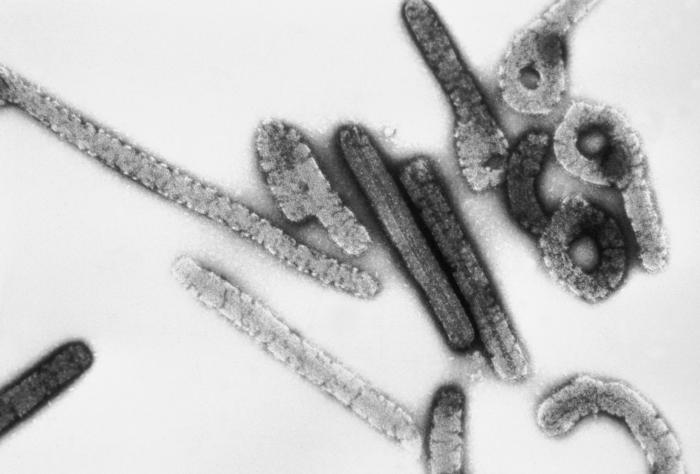Marburg virus, named after the former West German city of Marburg, also known as green monkey disease virus, green monkey factor, and Marburg virus, etc., is a deadly virus and the pathogenic source of Marburg hemorrhagic fever. Marburg virus is related to Ebola virus and also originated from Uganda and Kenya in Africa. It is a common disease of humans and other primates. The virus is transmitted from animals to humans, but the source of the virus is always unknown.
Marburg virus can be transmitted through body fluids, including blood, feces, saliva, and vomit. There is currently no vaccine or cure for this highly contagious and deadly disease. The patient’s symptoms are high fever, diarrhea, vomiting, and severe bleeding from various points of the body. Death usually occurs within a week of onset. Mortality rate is 25%-100%.

Marburg Virus Structure
The structure of Marburg virus is a typical filovirus, resembling a thread, the diameter is usually the same, but the length is between 80nm-14,000nm, and the length is usually about 790nm when the infectivity is strongest. Viral material consists of seven known proteins. The structure of Marburg virus is almost the same as Ebola, but the antibodies produced in the body of the infected person are different.
The Marburg virus genome is a single-stranded negative-stranded RNA, about 19kb long, encoding 7 viral proteins, including N protein (nucleoprotein, NP), viral protein 35 (VP35), viral protein 30 (VP30), viral protein 24 (VP24) , glycoprotein 4 (gp4), RNA-dependent RNA polymerase major component glycoprotein 7 (gp7) and minor component viral protein 40 (VP40).
Biological Properties of Marburg Virus
Marburg virus is moderately resistant to heat and cannot be completely inactivated at 56°C for 30 minutes, but the virus infectivity is lost after 1 hour at 60°C.The infectivity remains basically unchanged at room temperature and 4°C for 35 days, and can be stored for a long time at -70°C.A certain dose of ultraviolet rays, γ rays, lipid solvents, β-propiolactone, hypochlorous acid, phenols, etc. can be inactivated.
How the Marburg Virus Spreads
Non-human primates and patients infected with Marburg virus are the main source of infection. The virus is usually transmitted to humans by infected non-human primates (eg, green monkeys), and then from sick to other healthy people. Marburg virus is extremely contagious, the more severe the symptoms are, the more contagious it is, and the less contagious is the incubation period. It’s important to note that people are not part of the virus’ natural cycle and are only accidentally infected. The reservoir host of this virus in nature is unknown.
It is mainly transmitted through close contact, that is, contact with dead animals and dead bodies, as well as blood, secretions, excrement, vomit, droplets, etc. of infected animals and patients, through mucous membranes and damaged skin. In African epidemic areas, outbreaks of this disease have occurred many times due to exposure to patient corpses during funerals. Nosocomial and laboratory infections can also be caused by close contact. In addition, iatrogenic transmission can occur through the use of contaminated syringes, etc.. It has been reported that within 3 months of clinical recovery, Marburg virus can still be detected in semen, so there is the possibility of sexual transmission. In addition, the infection of experimental animals by aerosol containing this virus has also been reported.
Pathogenesis of Marburg Virus
After the Marburg virus enters the human body, it first invades dendritic cells and macrophages, and then it is carried to regional lymph nodes, spreads in the lymphatic system, and infects the liver, spleen and other tissues through the blood. The pathogenesis of this disease mainly includes the following two aspects:
- Virus infection of host cells results in direct damage to the cells. The mechanism is that the virus binds to the lectin on the cell surface, leading to cell necrosis through the toxicity of viral proteins.
- Viruses interact with the body’s immune system to cause indirect damage to cells.
The mechanism is: 1. The virus spreads from the invasion site to various systems, thereby inhibiting the body’s innate immune response, including the response of dendritic cells and macrophages to type I interferon; 2. Due to virus infection, dendritic cells respond to T cells. The activation of macrophages is partially inhibited, thereby affecting the humoral immune response; 3. A large number of lymphocyte apoptosis is produced throughout the infection process, resulting in immunosuppression; 4. The infected macrophages produce various mediators and cause severe lesions through various pathways. For example, the expression of tissue factor on the cell surface induces disseminated intravascular coagulation; the release of cytokines and chemokines leads to vascular dysfunction, hypotension and multiple organ failure.
